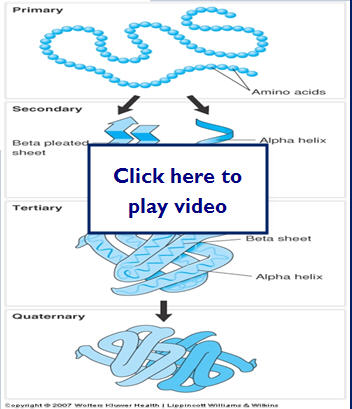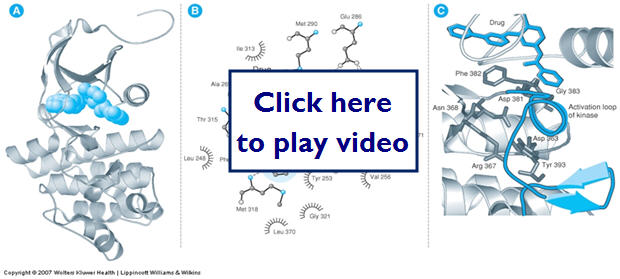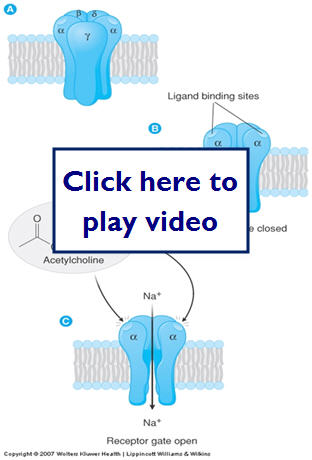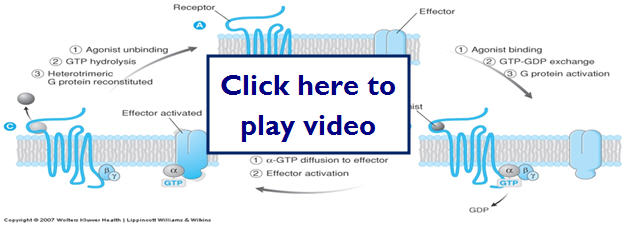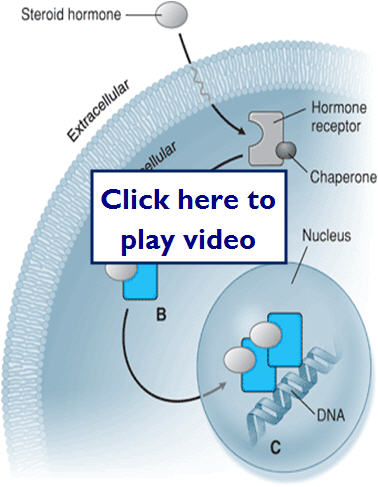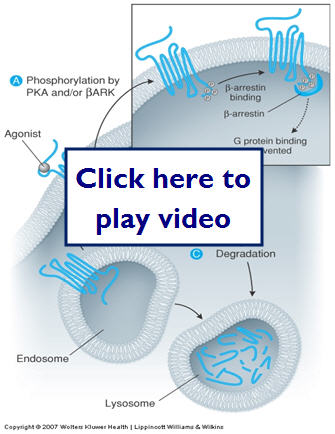Drug-Receptor Model
Protein Structure
Theoretically drugs can bind to almost any 3-D target. Desired effects (as well as adverse effects) occur when drugs bind to selected target molecules or receptors. This binding causes biochemical or physiological changes within the body. Receptors are macromolecules that mediate the biochemical or physiological changes that occur when the drug binds.
bind to selected target molecules or receptors. This binding causes biochemical or physiological changes within the body. Receptors are macromolecules that mediate the biochemical or physiological changes that occur when the drug binds.
Receptors are generally proteins. Proteins have 4 major levels of structure:
- Primary
- Secondary
- Tertiary
- Quaternary
Different parts of the protein have different affinities for water:
- Hydrophobic
- Hydrophillic
Let's take a look at how protein structure develops:
Drug Binding
The binding site on a receptor is where the drug actually binds. Binding is affected by many different types of interactions:
- van der Waals forces
- Hydrogen bonding
- Iononic interactions
- Covalent bonding (rare) is usually irreversible and creates an inactivated complex
- Drugs that act this way are sometimes referred to as suicide substrates
Now let's view an animation on drug receptor binding:
The animation above shows how drugs bind to cells.
The combination of all the interactions are what gives the drug its specificity. The favorability of the drug-receptor interaction is the affinity of the drug for the receptor (more later). Binding is rarely caused by one interaction. Stable Drug-receptor complexes usually have multiple interactions.
of the drug for the receptor (more later). Binding is rarely caused by one interaction. Stable Drug-receptor complexes usually have multiple interactions.
The molecular structure of a drug is what gives the drug its physical and chemical properties that determine how it will bind to the receptor. Important factors are:
- Hydrophobicity
- Ionization state (pKa)
- Conformation and stereochemistry
Warfarin-S enantiomer 4x more potent vs. R enantiomer due to it's ability to bind to the receptor.
Let's take a look at a drug molecule as it binds to its receptor in a protein. In this case it inhibits the enzymes action, but drugs can also stimulate action.
Active Site
In some cases drugs bind to sites that have enzymatic activity. This active site is where enzymatic transformation is catalyzed. If the drug inhibits binding of the normal substrate is inhibits the enzymes action. In other cases the drug may not bind to the active site.
In these cases the drug may change the shape of the receptor to increase or decrease substrate binding. Drugs can also bind and change the conformation of the receptor referred to as induced fit:
- Inactive (closed)
- Active (open)
- Desensitized (inactivated)
The structure of a drug can affect its ability to get to the receptor because of the plasma membrane. Highly water-soluble drugs are generally less able to pass through the plasma membrane or they need membrane channels or transporters. Highly lipophilic drugs cross easily and have good access to intracellular targets.
Drug Design
- Rational Drug Design
- gain knowledge of the structure of the receptor
- understand the factors affecting the receptor in order to determine the specificity between the drug and receptor
- increase efficacy and decrease toxicity by binding more selectively to the receptor
Let's now look at the drug receptor relationship in an equation type relationship:


k1 = association constant (drug on)
k2 = dissociation constant (drug off)
k1 / k2 = AFFINITY
k3 = EFFICACY
This equation represents a drug binding to a receptor and forming a drug receptor complex. Please note this is not a static process and may or may not elicit a response. We will talk more about this later in pharmacodynamics.
- Determinants of drug selectivity are:
- cell-type specificity of receptor subtypes
- cell-type specificity of receptor-effector coupling.
In general, the more restricted the cell-type distribution, the more selective the drug will be, and the more receptor-effector coupling mechanisms differ among the cell types targeted, the more selective the drug will be.
Receptor Types
- Types of drug-receptors are the following:
- Transmembrane ion channel
- Transmembrane linked to intracellular G protein
- Transmembrane with enzymatic cytosolic domain
- Intracellular
- Extracellular enzyme
- Adhesion
Now we can take a look at 4 common types of receptors and get a visual idea of the process of drug binding to its receptor:
- Transmembrane ion channels
- Major mechanism to regulate
- Ligand-gated
- Voltage gated
- Second messenger regulated
Let's look at regulation of an ion channel. This is an example of a Ligand-gated.
- Transmembrane G protein-coupled receptors
- Most abundant class of receptors in humans
- Exposed at the surface of the cell membrane
- Traverse through the membrane
- Have intracellular regions that activate signaling molecules called G proteins
- G proteins bind to GTP and GDP
- A major role for G proteins is to activate the production of second messengers
Now let's look at G-protein coupled receptors and what happens when an agonist binds to the receptor:
- Transmembrane receptors with enzymatic cytosolic domains
- 5 major types
- Tyrosine kinases (largest group)
- Tyrosine phosphatases
- Tyrosine kinase-associated receptors
- Receptor serine/threonine kinases
- Receptor Guanylyl cyclases
- Have roles in cell metabolism, growth and differentiation
- Intracellular receptors
- Intracellular targets can be enzymes
- Alter signaling or metabolic molecules
- Lipophillic drugs can target cytosolic receptors that affect transcription regulatory factors
- Steroid hormones
- Can also act on cytosolic structural proteins
- Antimicrobial and antineoplastic chemotherapy
Here we'll take a look at how a steroid hormone can diffuse through the cell membrane to act at an intercellular target receptor:
- Extracellular enzymes
- Target is outside the plasma membrane
- Can target enzymes that convert or modify molecules that can influence physiological processes
- ACEIs (inhibit angiotesin I to angiotesin II)
- Cell surface adhesion receptors
- Adhesion is when 2 cells have an area of contact between them.
- This adhesion is required for some functions to occur and is mediated by receptors
- Formation of tissue
- Migration of immune cells to a site of inflammation
Cellular Regulation
- Cellular regulation
- Overstimulation or inhibition of receptors can lead to cell damage or adverse effects to the body as a whole.
- Over time the receptors may become desensitized to the drug ( decreased ability to respond to stimuli).
- Homologous-only one type of receptor diminished
- Heterologous-two or more
- Receptors can also become inactivated
- Receptor becomes completely turned off
- Receptors may also have altered refractory times (refractoriness)
- Time before receptor can be stimulated again
- Voltage gated ion channels
- Downregulation-repeated or persistent DR interaction causes a removal of receptors of sites available for interaction
- Endocytosis sequesters the receptors
- Cells can also alter the level of synthesis of receptors, which also regulates the number of receptors available for binding
Now let's take a look at how cells can up regulate and down regulate receptors:
Not all drugs interact with receptors. Osmotic diuretics act on ion channels and change osmolarity of nephron directly. Antacids absorb or chemically neutralize acid.

